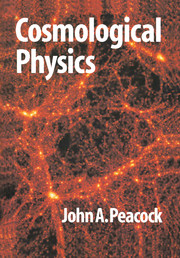Book contents
- Frontmatter
- Contents
- Preface
- Part 1 Gravitation and relativity
- 1 Essentials of general relativity
- 2 Astrophysical relativity
- Part 2 Classical cosmology
- Part 3 Basics of quantum fields
- Part 4 The early universe
- Part 5 Observational cosmology
- Part 6 Galaxy formation and clustering
- Hints for solution of the problems
- Bibliography and references
- Useful numbers and formulae
- Index
1 - Essentials of general relativity
Published online by Cambridge University Press: 05 June 2012
- Frontmatter
- Contents
- Preface
- Part 1 Gravitation and relativity
- 1 Essentials of general relativity
- 2 Astrophysical relativity
- Part 2 Classical cosmology
- Part 3 Basics of quantum fields
- Part 4 The early universe
- Part 5 Observational cosmology
- Part 6 Galaxy formation and clustering
- Hints for solution of the problems
- Bibliography and references
- Useful numbers and formulae
- Index
Summary
The concepts of general relativity
special relativity To understand the issues involved in general relativity, it is helpful to begin with a brief summary of the way space and time are treated in special relativity. The latter theory is an elaboration of the intuitive point of view that the properties of empty space should be the same throughout the universe. This is just a generalization of everyday experience: the world in our vicinity looks much the same whether we are stationary or in motion (leaving aside the inertial forces experienced by accelerated observers, to which we will return shortly).
The immediate consequence of this assumption is that any process that depends only on the properties of empty space must appear the same to all observers: the velocity of light or gravitational radiation should be a constant. The development of special relativity can of course proceed from the experimental constancy of c, as revealed by the Michelson-Morley experiment, but it is worth noting that Einstein considered the result of this experiment to be inevitable on intuitive grounds (see Pais 1982 for a detailed account of the conceptual development of relativity). Despite the mathematical complexity that can result, general relativity is at heart a highly intuitive theory; the way in which our everyday experience can be generalized to deduce the large-scale structure of the universe is one of the most magical parts of physics.
- Type
- Chapter
- Information
- Cosmological Physics , pp. 3 - 34Publisher: Cambridge University PressPrint publication year: 1998



